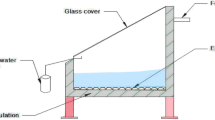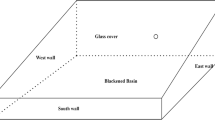Abstract
The demand for fresh water is rapidly growing as a consequence of the increasing population and urbanization. Tubular solar still offers larger evaporative and condensing surface area as compared to single slope solar still. The aim of this study is to improve the performance of tubular solar still by employing eggshell powder (collected from Babcobb Broilers chicken) as the sensible energy storage material in form of bed, placed inside the basin of still to improve the water production. Results showed that the influence of eggshell powder as energy storage material in the basin improved the average water temperature by 3%, 6.2%, and 3.2% for the water thickness of 10, 15, and 20 mm, respectively. The usage of eggshells as a sensible energy storage in the basin augmented the peak hourly water yield by 67.64% with minimum water thickness. The total observed distillate output from the solar still is 1.45 kg without eggshell powder and 2.67 kg for with eggshell powder in the absorber at the lowest water thickness of 10 mm. TSS with eggshell powder as energy storage has a daily energy efficiency of 48.17%, 42.38%, and 36.38%, respectively, for water thicknesses of 10, 15, and 20 mm in the basin. Water thickness of 10, 15, and 20 mm has performance improvement ratios of 1.83, 1.81, and 1.78, respectively. Using cost analysis, it was found that the cost of drinkable water generated using eggshell as an energy storage material is 0.011$/kg, but the cost of water by traditional still without any storage material was 0.021$/kg.













Similar content being viewed by others
Data Availability
Not applicable.
Abbreviations
- AC:
-
area of cover (m2)
- CSS:
-
conventional solar still.
- hfg:
-
latent heat of condensation (J/kg).
- I(t):
-
solar radiation (W/m2).
- me:
-
mass of distillate collected (kg).
- PCM:
-
Phase change material
- TSS:
-
tubular solar still.
References
Abdelaziz GB, Algazzar AM, El-Said EM, Elsaid AM, Sharshir SW, Kabeel AE, El-Behery SM (2021) Performance enhancement of tubular solar still using nano-enhanced energy storage material integrated with v-corrugated aluminum basin, wick, and nanofluid. J Energy Storage 41:102933
Abdelgaied M, Zakaria Y, Kabeel AE, Essa FA (2021) Improving the tubular solar still performance using square and circular hollow fins with phase change materials. J Energy Storage 38:102564
Abd Elaziz, Mohamed, F. A. Essa, and Ammar H. Elsheikh. “Utilization of ensemble random vector functional link network for freshwater prediction of active solar stills with nanoparticles.” Sustainable Energy Technologies and Assessments 47 (2021): 101405.
Ahmed MM, Alshammari F, Abdullah AS, Elashmawy M (2021) Basin and tubular solar distillation systems: a review. Process Saf Environ Protect 150:157–178
Alshammari F, Elashmawy M, Ahmed MM (2021) Cleaner production of freshwater using multi-effect tubular solar still. J Cleaner Prod 281:125301
Arani RP, Sathyamurthy R, Chamkha A, Kabeel AE, Deverajan M, Kamalakannan K, Balasubramanian M, Manokar AM, Essa F, Saravanan A (2021) Effect of fins and silicon dioxide nanoparticle black paint on the absorber plate for augmenting yield from tubular solar still. Environ Sci Pollut Res 28(26):35102–35112
Arunkumar T, Wang J, Rufuss DDW, Denkenberger D, Kabeel AE (2020) Sensible desalting: investigation of sensible thermal storage materials in solar stills. J Energy Storage 32:101824
Athikesavan, M. M., Márquez, F. P. G., Rafeek, M. T. M., & Sathyamurthy, R. (2021, August). Annual yield, energy and economic analysis of tubular solar stills with phase change material and nano-enhanced phase change material. In International Conference on Management Science and Engineering Management (pp. 463–472). Springer, Cham.
Bait O (2019) Exergy, environ–economic and economic analyses of a tubular solar water heater assisted solar still. J Clean Prod 212:630–646
Balachandran GB, David PW, Rajendran G, Ali MNA, Radhakrishnan V, Balamurugan R, Athikesavan M, Sathyamurthy R (2021) Investigation of performance enhancement of solar still incorporated with Gallus gallus domesticus cascara as sensible heat storage material. Environ Sci Pollut Res 28(1):611–624
Bilal A, Jamil B, Haque NU, Ansari MA (2019) Investigating the effect of pumice stones sensible heat storage on the performance of a solar still. Groundw Sustain Dev 9:100228
Čáchová M, Koňáková D, Vejmelková E, Keppert M, Černý R (2016). Mechanical and thermal properties of the Czech marbles. In AIP Conference Proceedings (Vol. 1738, No. 1, p. 280010). AIP Publishing LLC
Chamkha AJ, Rufuss DDW, Kabeel AE, Sathyamurthy R, Abdelgaid M, Manokar AM, Madhu B (2020) Augmenting the potable water produced from single slope solar still using CNT-doped paraffin wax as energy storage: an experimental approach. J Braz Soc Mech Sci Eng 42(12):1–10
Denys S, Pieters JG, Dewettinck K (2004) Computational fluid dynamics analysis of combined conductive and convective heat transfer in model eggs. J Food Eng 63:281–290
Deshmukh HS, Thombre SB (2017) Solar distillation with single basin solar still using sensible heat storage materials. Desalination 410:91–98
El-Sebaii AA, Yaghmour SJ, Al-Hazmi FS, Faidah AS, Al-Marzouki FM, Al-Ghamdi AA (2009) Active single basin solar still with a sensible storage medium. Desalination 249(2):699–706
Essa FA, Alawee WH, Mohammed SA, Dhahad HA, Abdullah AS, Omara ZM (2021) Experimental investigation of convex tubular solar still performance using wick and nanocomposites. Case Studies in Therm Eng 27:101368
Holman JP (1994) Experimental methods for engineers, 6th edn. McGraw-Hill, Singapore
Kabeel AE, Elkelawy M, El Din HA, Alghrubah A (2017) Investigation of exergy and yield of a passive solar water desalination system with a parabolic concentrator incorporated with latent heat storage medium. Energy Convers Manage 145:10–19
Kabeel AE, Abdelgaied M, Eisa A (2018a) Enhancing the performance of single basin solar still using high thermal conductivity sensible storage materials. J Clean Prod 183:20–25
Kabeel AE, El-Agouz SA, Sathyamurthy R, Arunkumar T (2018b) Augmenting the productivity of solar still using jute cloth knitted with sand heat energy storage. Desalination 443:122–129
Kabeel AE, Abdelaziz GB, El-Said EM (2019) Experimental investigation of a solar still with composite material heat storage: energy, exergy and economic analysis. J Clean Prod 231:21–34
Kabeel AE, Harby K, Abdelgaied M, Eisa A (2020) Performance of the modified tubular solar still integrated with cylindrical parabolic concentrators. Sol Energy 204:181–189
Kabeel AE, Harby K, Abdelgaied M, Eisa A (2021) Performance improvement of a tubular solar still using v-corrugated absorber with wick materials: numerical and experimental investigations. Sol Energy 217:187–199
Kandeal AW, El-Shafai NM, Abdo MR, Thakur AK, El-Mehasseb IM, Maher I, Rashad M, Kabeel AE, Yang N, Sharshir SW (2021) Improved thermo-economic performance of solar desalination via copper chips, nanofluid, and nano-based phase change material. Sol Energy 224:1313–1325
Kedida, D. K., Amibe, D. A., & Birhane, Y. T. (2019). Performance of a pebble bed thermal storage integrated with concentrating parabolic solar collector for cooking. Journal of Renewable Energy, 2019.
Madhu B, Balasubramanian E, Nagarajan PK, Ravishankar S, Kabeel AE, Arunkumar T, Mageshbabu D (2017) Improving the yield of fresh water from conventional and stepped solar still with different nanofluids. Desalin Water Treat 100:243–249
Madhu, B., Balasubramanian, E., Kabeel, A. E., Sathyamurthy, R., El‐Agouz, E. S., & Muthu Manokar, A. (2019). Experimental investigation on the effect of photovoltaic panel partially and fully submerged in water. Heat Transfer—Asian Research, 48(5), 1709–1721.
Murugavel KK, Srithar K (2011) Performance study on basin type double slope solar still with different wick materials and minimum mass of water. Renewable Energy 36(2):612–620
Murugavel KK, Sivakumar S, Ahamed JR, Chockalingam KK, Srithar K (2010) Single basin double slope solar still with minimum basin depth and energy storing materials. Appl Energy 87(2):514–523
Samuel DH, Nagarajan PK, Sathyamurthy R, El-Agouz SA, Kannan E (2016) Improving the yield of fresh water in conventional solar still using low cost energy storage material. Energy Convers Manage 112:125–134
Sathyamurthy R, El-Agouz SA, Nagarajan PK, Subramani J, Arunkumar T, Mageshbabu D, Madhu B, Bharathwaaj R, Prakash N (2017) A review of integrating solar collectors to solar still. Renew Sustain Energy Rev 77:1069–1097
Sharshir SW, Peng G, Elsheikh AH, Edreis EM, Eltawil MA, Abdelhamid T, Kabeel AE, Zang J, Yang N (2018) Energy and exergy analysis of solar stills with micro/nano particles: a comparative study. Energy Convers Manage 177:363–375
Sharshir SW, Elkadeem MR, Meng A (2020) Performance enhancement of pyramid solar distiller using nanofluid integrated with v-corrugated absorber and wick: an experimental study. Appl Therm Eng 168:114848
Sharshir SW, Hamada MA, Kandeal AW, El-Said EM, Elsaid AM, Rashad M, Abdelaziz GB (2021) Augmented performance of tubular solar still integrated with cost-effective nano-based mushrooms. Sol Energy 228:27–37
Shoeibi S, Rahbar N, Esfahlani AA, Kargarsharifabad H (2021) A comprehensive review of Enviro-Exergo-economic analysis of solar stills. Renew Sust Energ Rev 149:111404
Shoeibi S, Rahbar N, Esfahlani AA, Kargarsharifabad H (2021) A review of techniques for simultaneous enhancement of evaporation and condensation rates in solar stills. Sol Energy 225:666–693
Vaithilingam S, Gopal ST, Srinivasan SK, Manokar AM, Sathyamurthy R, Esakkimuthu GS, Kumar R, Sharifpur M (2021) An extensive review on thermodynamic aspect based solar desalination techniques. J Therm Anal Calorim 145(3):1103–1119
Yan T, Xie G, Chen W, Wu Z, Xu J, Liu Y (2021) Experimental study on three-effect tubular solar still under vacuum and immersion cooling. Desalination 515:115211
Acknowledgements
Amrit Kumar Thakur would like to acknowledge KPR Institute of Engineering and Technology, Coimbatore, India for providing the Fellowship.
Author information
Authors and Affiliations
Contributions
Amrit Kumar Thakur: conceptualization, methodology, investigation, validation, and writing — reviewing; formal analysis.
Ravishankar Sathyamurthy: conceptualization, methodology, investigation, validation, and writing — reviewing; formal analysis, project administration, and supervision.
Corresponding author
Ethics declarations
Ethics approval
Not applicable.
Consent to participate
Not applicable.
Consent for publication
Not applicable.
Competing interests
The authors declare no competing interests.
Additional information
Responsible Editor: Philippe Garrigues
Publisher's note
Springer Nature remains neutral with regard to jurisdictional claims in published maps and institutional affiliations.
Rights and permissions
About this article
Cite this article
Thakur, A.K., Sathyamurthy, R. Improving the potable water generation through tubular solar still using eggshell powder (bio-based energy source) as a natural energy storage material — an experimental approach. Environ Sci Pollut Res 29, 40903–40920 (2022). https://doi.org/10.1007/s11356-022-18906-8
Received:
Accepted:
Published:
Issue Date:
DOI: https://doi.org/10.1007/s11356-022-18906-8




